Strategic Finance Homework: Present Value, Bonds, and Stock Valuation
VerifiedAdded on 2022/11/29
|11
|1388
|241
Homework Assignment
AI Summary
This homework assignment on strategic finance covers several key concepts including present value calculations, bond valuation, and stock valuation using various models. The student calculates the present value of an annuity under different time horizons and considers the impact of inflation. Bond pricing is determined based on face value, coupon rate, yield to maturity, and maturity period, with analysis of bond prices before and after coupon payments. The assignment also involves the application of the dividend growth model to forecast earnings and stock prices, considering different payout and retention ratios. Additionally, the student addresses portfolio return and standard deviation calculations, and utilizes the binomial model and Black-Scholes model for call option valuation. The assignment demonstrates a solid understanding of financial concepts and their application in practical scenarios.
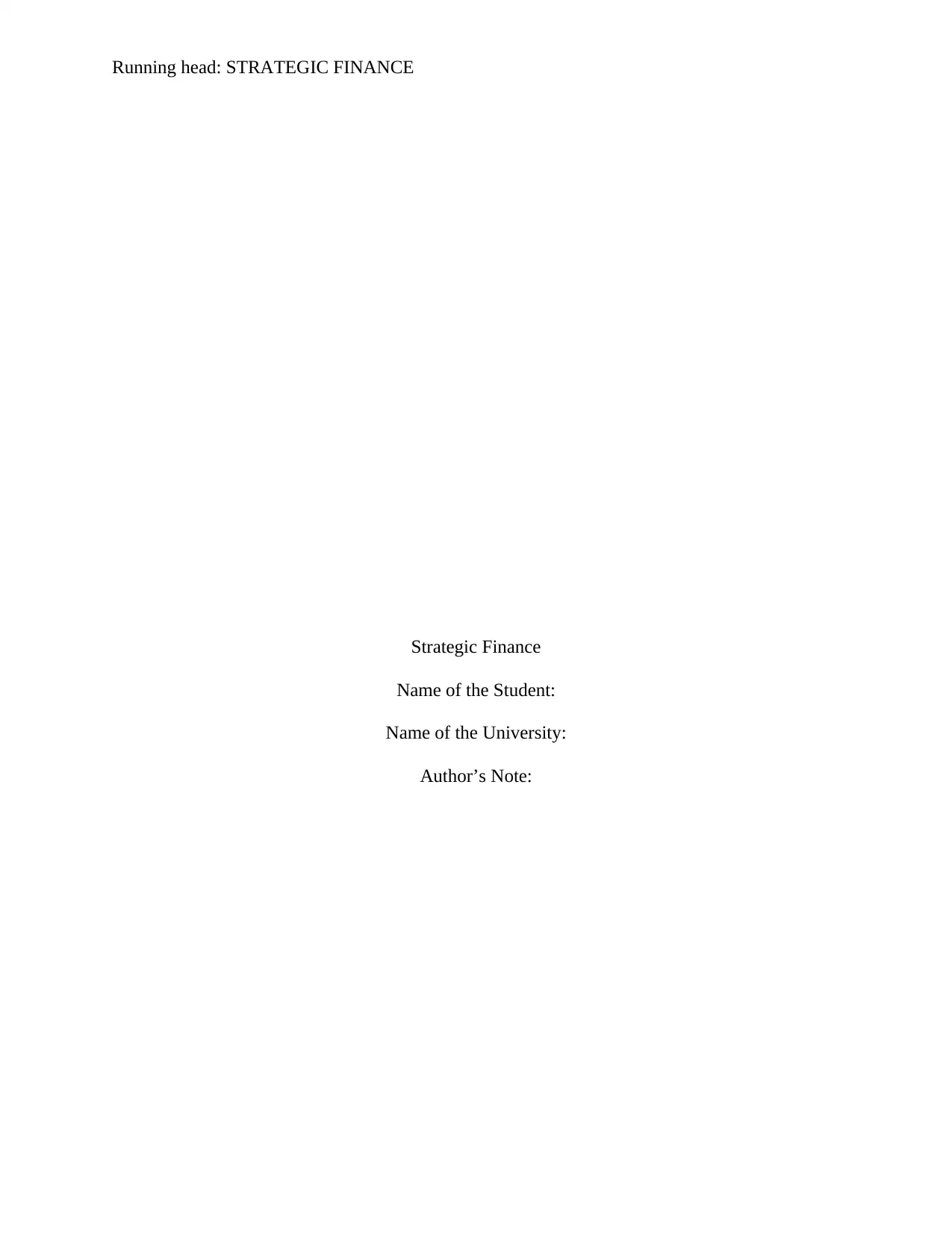
Running head: STRATEGIC FINANCE
Strategic Finance
Name of the Student:
Name of the University:
Author’s Note:
Strategic Finance
Name of the Student:
Name of the University:
Author’s Note:
Paraphrase This Document
Need a fresh take? Get an instant paraphrase of this document with our AI Paraphraser
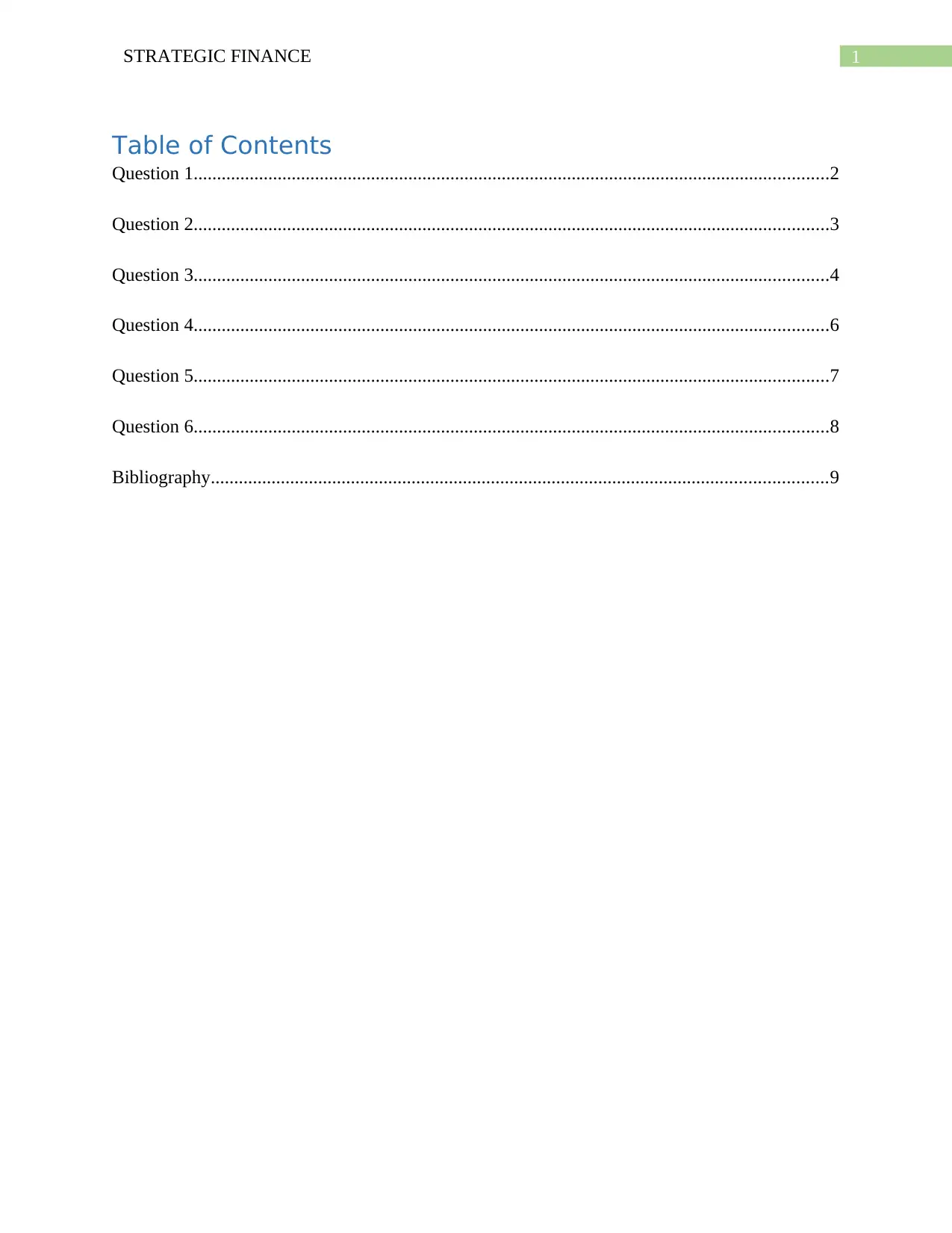
1STRATEGIC FINANCE
Table of Contents
Question 1........................................................................................................................................2
Question 2........................................................................................................................................3
Question 3........................................................................................................................................4
Question 4........................................................................................................................................6
Question 5........................................................................................................................................7
Question 6........................................................................................................................................8
Bibliography....................................................................................................................................9
Table of Contents
Question 1........................................................................................................................................2
Question 2........................................................................................................................................3
Question 3........................................................................................................................................4
Question 4........................................................................................................................................6
Question 5........................................................................................................................................7
Question 6........................................................................................................................................8
Bibliography....................................................................................................................................9
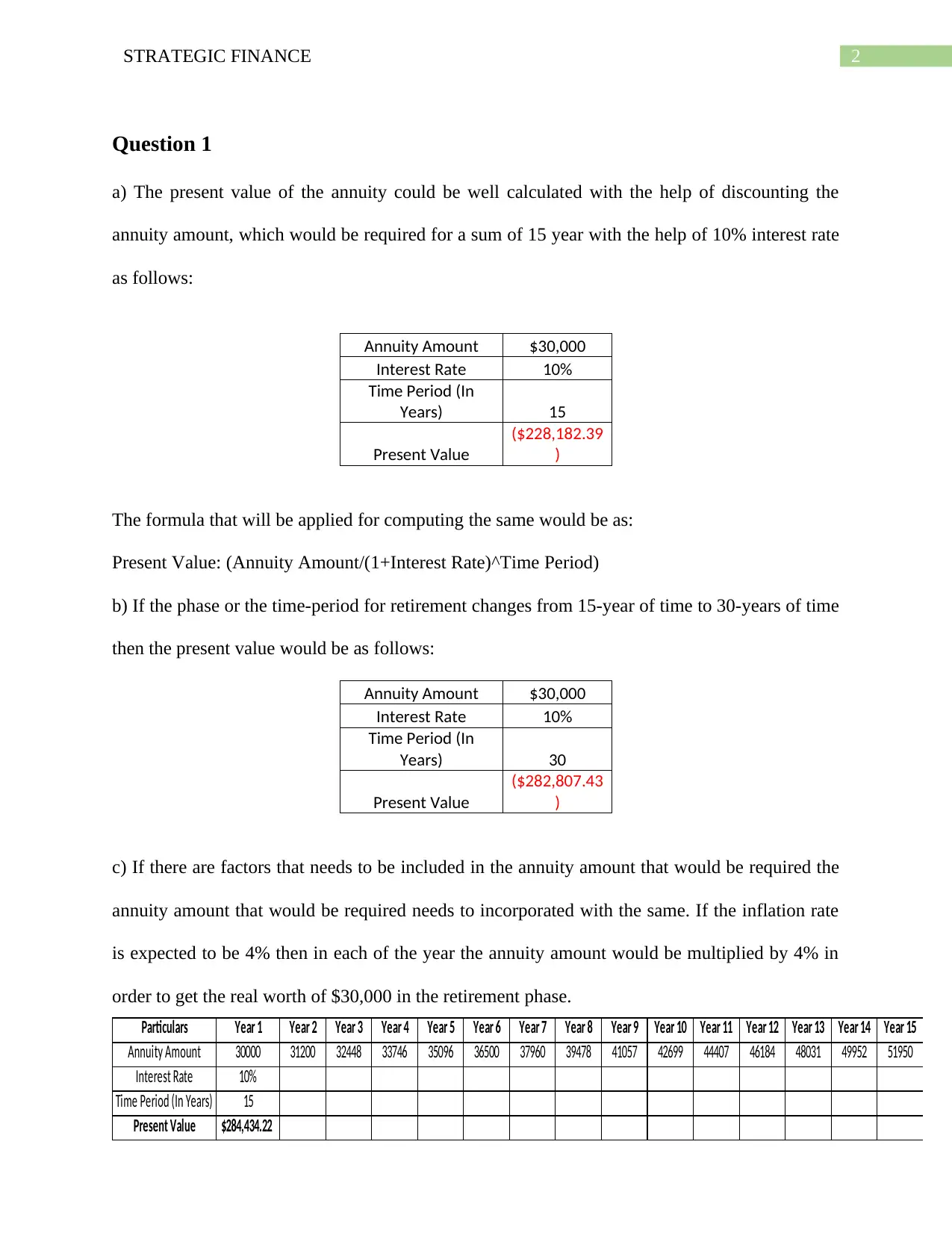
2STRATEGIC FINANCE
Question 1
a) The present value of the annuity could be well calculated with the help of discounting the
annuity amount, which would be required for a sum of 15 year with the help of 10% interest rate
as follows:
Annuity Amount $30,000
Interest Rate 10%
Time Period (In
Years) 15
Present Value
($228,182.39
)
The formula that will be applied for computing the same would be as:
Present Value: (Annuity Amount/(1+Interest Rate)^Time Period)
b) If the phase or the time-period for retirement changes from 15-year of time to 30-years of time
then the present value would be as follows:
Annuity Amount $30,000
Interest Rate 10%
Time Period (In
Years) 30
Present Value
($282,807.43
)
c) If there are factors that needs to be included in the annuity amount that would be required the
annuity amount that would be required needs to incorporated with the same. If the inflation rate
is expected to be 4% then in each of the year the annuity amount would be multiplied by 4% in
order to get the real worth of $30,000 in the retirement phase.
Particulars Year 1 Year 2 Year 3 Year 4 Year 5 Year 6 Year 7 Year 8 Year 9 Year 10 Year 11 Year 12 Year 13 Year 14 Year 15
Annuity Amount 30000 31200 32448 33746 35096 36500 37960 39478 41057 42699 44407 46184 48031 49952 51950
Interest Rate 10%
Time Period (In Years) 15
Present Value $284,434.22
Question 1
a) The present value of the annuity could be well calculated with the help of discounting the
annuity amount, which would be required for a sum of 15 year with the help of 10% interest rate
as follows:
Annuity Amount $30,000
Interest Rate 10%
Time Period (In
Years) 15
Present Value
($228,182.39
)
The formula that will be applied for computing the same would be as:
Present Value: (Annuity Amount/(1+Interest Rate)^Time Period)
b) If the phase or the time-period for retirement changes from 15-year of time to 30-years of time
then the present value would be as follows:
Annuity Amount $30,000
Interest Rate 10%
Time Period (In
Years) 30
Present Value
($282,807.43
)
c) If there are factors that needs to be included in the annuity amount that would be required the
annuity amount that would be required needs to incorporated with the same. If the inflation rate
is expected to be 4% then in each of the year the annuity amount would be multiplied by 4% in
order to get the real worth of $30,000 in the retirement phase.
Particulars Year 1 Year 2 Year 3 Year 4 Year 5 Year 6 Year 7 Year 8 Year 9 Year 10 Year 11 Year 12 Year 13 Year 14 Year 15
Annuity Amount 30000 31200 32448 33746 35096 36500 37960 39478 41057 42699 44407 46184 48031 49952 51950
Interest Rate 10%
Time Period (In Years) 15
Present Value $284,434.22
⊘ This is a preview!⊘
Do you want full access?
Subscribe today to unlock all pages.

Trusted by 1+ million students worldwide
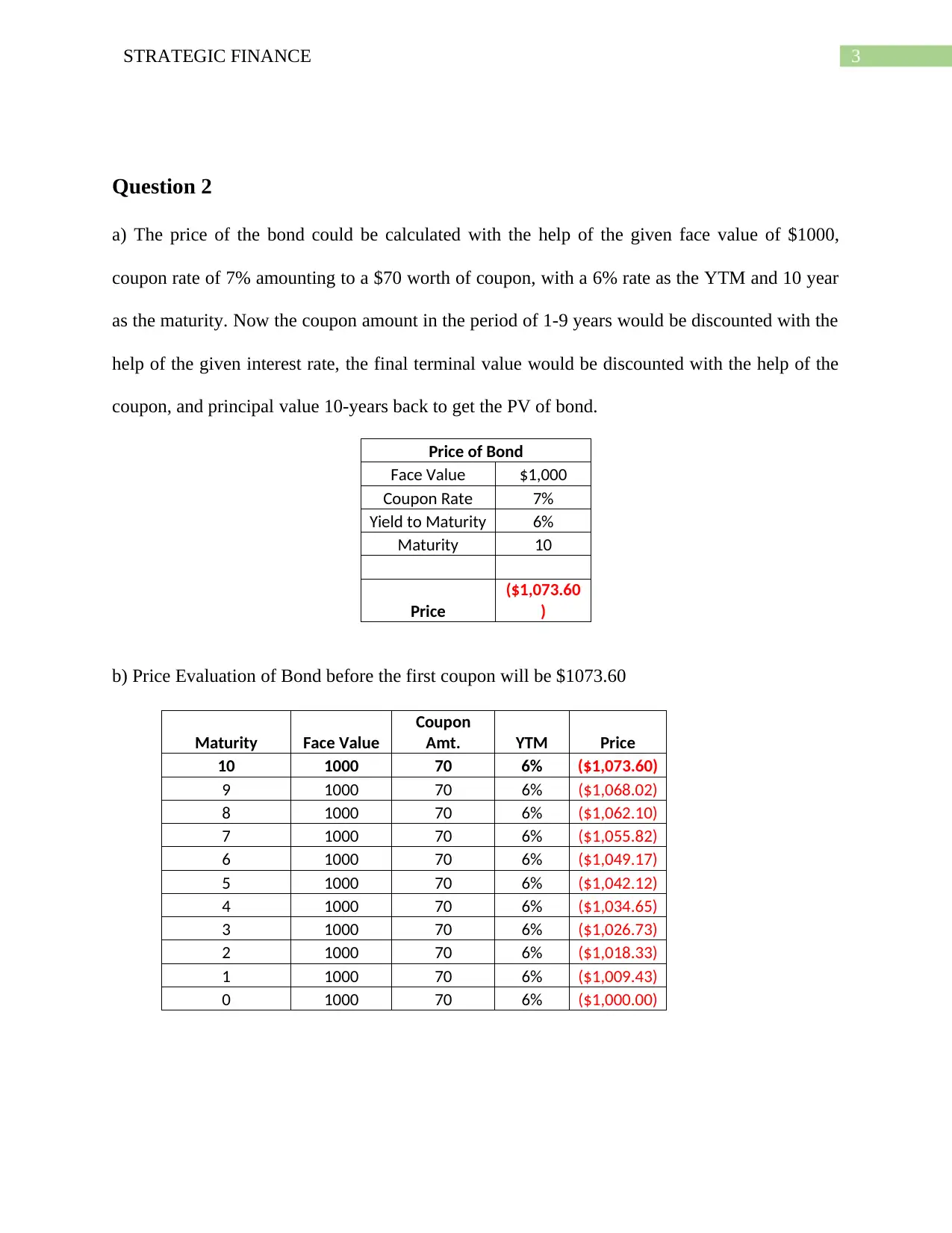
3STRATEGIC FINANCE
Question 2
a) The price of the bond could be calculated with the help of the given face value of $1000,
coupon rate of 7% amounting to a $70 worth of coupon, with a 6% rate as the YTM and 10 year
as the maturity. Now the coupon amount in the period of 1-9 years would be discounted with the
help of the given interest rate, the final terminal value would be discounted with the help of the
coupon, and principal value 10-years back to get the PV of bond.
Price of Bond
Face Value $1,000
Coupon Rate 7%
Yield to Maturity 6%
Maturity 10
Price
($1,073.60
)
b) Price Evaluation of Bond before the first coupon will be $1073.60
Maturity Face Value
Coupon
Amt. YTM Price
10 1000 70 6% ($1,073.60)
9 1000 70 6% ($1,068.02)
8 1000 70 6% ($1,062.10)
7 1000 70 6% ($1,055.82)
6 1000 70 6% ($1,049.17)
5 1000 70 6% ($1,042.12)
4 1000 70 6% ($1,034.65)
3 1000 70 6% ($1,026.73)
2 1000 70 6% ($1,018.33)
1 1000 70 6% ($1,009.43)
0 1000 70 6% ($1,000.00)
Question 2
a) The price of the bond could be calculated with the help of the given face value of $1000,
coupon rate of 7% amounting to a $70 worth of coupon, with a 6% rate as the YTM and 10 year
as the maturity. Now the coupon amount in the period of 1-9 years would be discounted with the
help of the given interest rate, the final terminal value would be discounted with the help of the
coupon, and principal value 10-years back to get the PV of bond.
Price of Bond
Face Value $1,000
Coupon Rate 7%
Yield to Maturity 6%
Maturity 10
Price
($1,073.60
)
b) Price Evaluation of Bond before the first coupon will be $1073.60
Maturity Face Value
Coupon
Amt. YTM Price
10 1000 70 6% ($1,073.60)
9 1000 70 6% ($1,068.02)
8 1000 70 6% ($1,062.10)
7 1000 70 6% ($1,055.82)
6 1000 70 6% ($1,049.17)
5 1000 70 6% ($1,042.12)
4 1000 70 6% ($1,034.65)
3 1000 70 6% ($1,026.73)
2 1000 70 6% ($1,018.33)
1 1000 70 6% ($1,009.43)
0 1000 70 6% ($1,000.00)
Paraphrase This Document
Need a fresh take? Get an instant paraphrase of this document with our AI Paraphraser
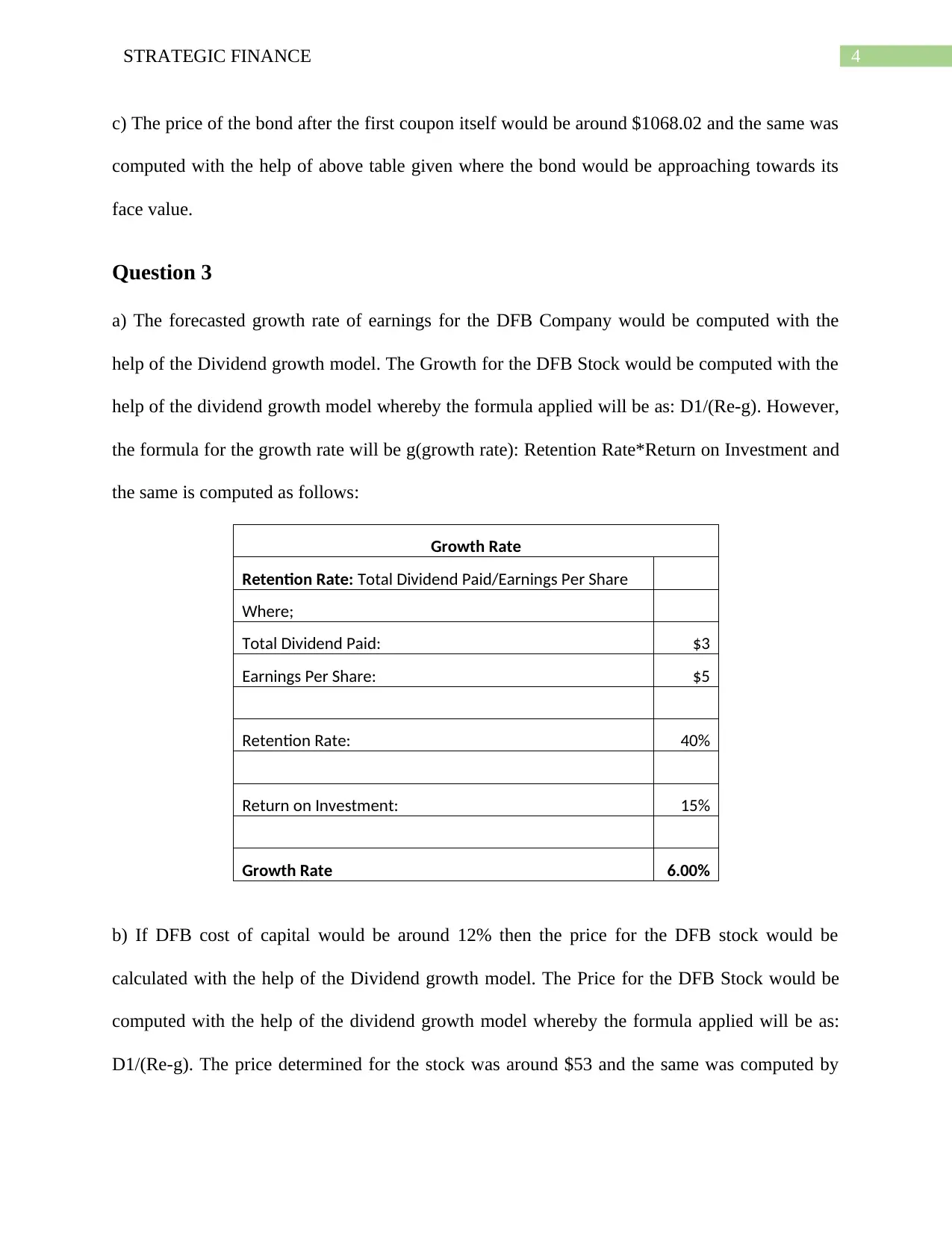
4STRATEGIC FINANCE
c) The price of the bond after the first coupon itself would be around $1068.02 and the same was
computed with the help of above table given where the bond would be approaching towards its
face value.
Question 3
a) The forecasted growth rate of earnings for the DFB Company would be computed with the
help of the Dividend growth model. The Growth for the DFB Stock would be computed with the
help of the dividend growth model whereby the formula applied will be as: D1/(Re-g). However,
the formula for the growth rate will be g(growth rate): Retention Rate*Return on Investment and
the same is computed as follows:
Growth Rate
Retention Rate: Total Dividend Paid/Earnings Per Share
Where;
Total Dividend Paid: $3
Earnings Per Share: $5
Retention Rate: 40%
Return on Investment: 15%
Growth Rate 6.00%
b) If DFB cost of capital would be around 12% then the price for the DFB stock would be
calculated with the help of the Dividend growth model. The Price for the DFB Stock would be
computed with the help of the dividend growth model whereby the formula applied will be as:
D1/(Re-g). The price determined for the stock was around $53 and the same was computed by
c) The price of the bond after the first coupon itself would be around $1068.02 and the same was
computed with the help of above table given where the bond would be approaching towards its
face value.
Question 3
a) The forecasted growth rate of earnings for the DFB Company would be computed with the
help of the Dividend growth model. The Growth for the DFB Stock would be computed with the
help of the dividend growth model whereby the formula applied will be as: D1/(Re-g). However,
the formula for the growth rate will be g(growth rate): Retention Rate*Return on Investment and
the same is computed as follows:
Growth Rate
Retention Rate: Total Dividend Paid/Earnings Per Share
Where;
Total Dividend Paid: $3
Earnings Per Share: $5
Retention Rate: 40%
Return on Investment: 15%
Growth Rate 6.00%
b) If DFB cost of capital would be around 12% then the price for the DFB stock would be
calculated with the help of the Dividend growth model. The Price for the DFB Stock would be
computed with the help of the dividend growth model whereby the formula applied will be as:
D1/(Re-g). The price determined for the stock was around $53 and the same was computed by
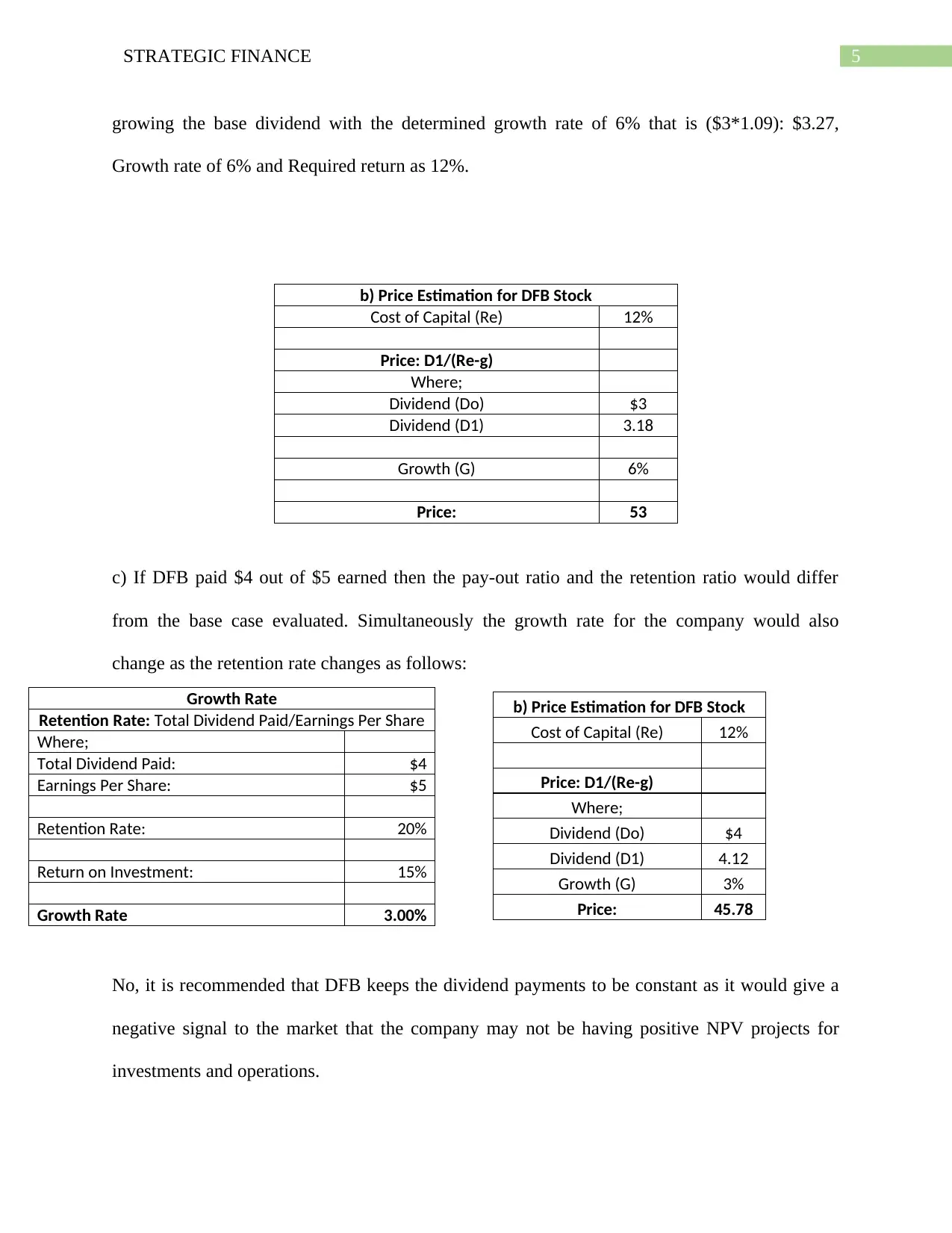
5STRATEGIC FINANCE
growing the base dividend with the determined growth rate of 6% that is ($3*1.09): $3.27,
Growth rate of 6% and Required return as 12%.
b) Price Estimation for DFB Stock
Cost of Capital (Re) 12%
Price: D1/(Re-g)
Where;
Dividend (Do) $3
Dividend (D1) 3.18
Growth (G) 6%
Price: 53
c) If DFB paid $4 out of $5 earned then the pay-out ratio and the retention ratio would differ
from the base case evaluated. Simultaneously the growth rate for the company would also
change as the retention rate changes as follows:
No, it is recommended that DFB keeps the dividend payments to be constant as it would give a
negative signal to the market that the company may not be having positive NPV projects for
investments and operations.
Growth Rate
Retention Rate: Total Dividend Paid/Earnings Per Share
Where;
Total Dividend Paid: $4
Earnings Per Share: $5
Retention Rate: 20%
Return on Investment: 15%
Growth Rate 3.00%
b) Price Estimation for DFB Stock
Cost of Capital (Re) 12%
Price: D1/(Re-g)
Where;
Dividend (Do) $4
Dividend (D1) 4.12
Growth (G) 3%
Price: 45.78
growing the base dividend with the determined growth rate of 6% that is ($3*1.09): $3.27,
Growth rate of 6% and Required return as 12%.
b) Price Estimation for DFB Stock
Cost of Capital (Re) 12%
Price: D1/(Re-g)
Where;
Dividend (Do) $3
Dividend (D1) 3.18
Growth (G) 6%
Price: 53
c) If DFB paid $4 out of $5 earned then the pay-out ratio and the retention ratio would differ
from the base case evaluated. Simultaneously the growth rate for the company would also
change as the retention rate changes as follows:
No, it is recommended that DFB keeps the dividend payments to be constant as it would give a
negative signal to the market that the company may not be having positive NPV projects for
investments and operations.
Growth Rate
Retention Rate: Total Dividend Paid/Earnings Per Share
Where;
Total Dividend Paid: $4
Earnings Per Share: $5
Retention Rate: 20%
Return on Investment: 15%
Growth Rate 3.00%
b) Price Estimation for DFB Stock
Cost of Capital (Re) 12%
Price: D1/(Re-g)
Where;
Dividend (Do) $4
Dividend (D1) 4.12
Growth (G) 3%
Price: 45.78
⊘ This is a preview!⊘
Do you want full access?
Subscribe today to unlock all pages.

Trusted by 1+ million students worldwide

6STRATEGIC FINANCE
Paraphrase This Document
Need a fresh take? Get an instant paraphrase of this document with our AI Paraphraser
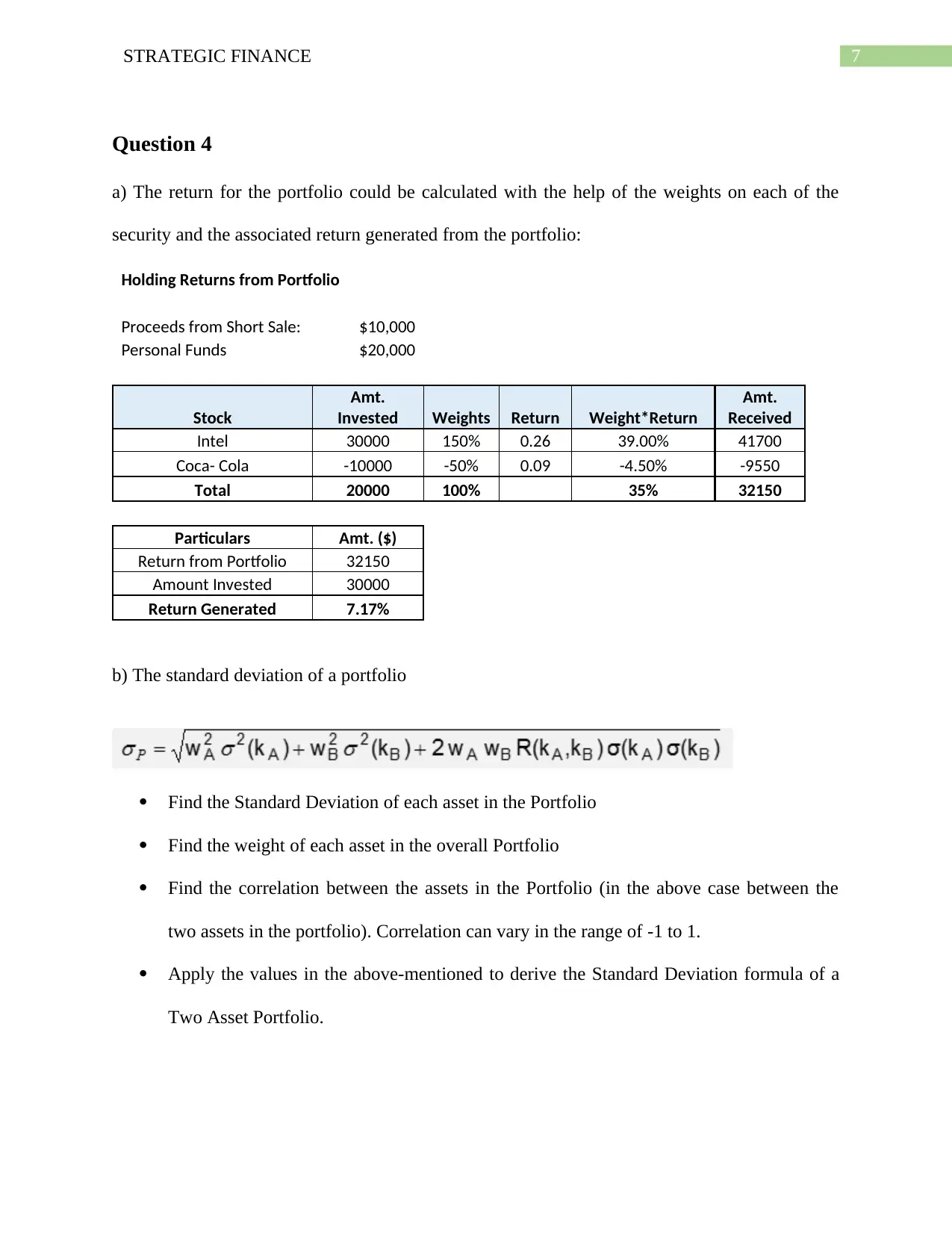
7STRATEGIC FINANCE
Question 4
a) The return for the portfolio could be calculated with the help of the weights on each of the
security and the associated return generated from the portfolio:
Holding Returns from Portfolio
Proceeds from Short Sale: $10,000
Personal Funds $20,000
Stock
Amt.
Invested Weights Return Weight*Return
Amt.
Received
Intel 30000 150% 0.26 39.00% 41700
Coca- Cola -10000 -50% 0.09 -4.50% -9550
Total 20000 100% 35% 32150
Particulars Amt. ($)
Return from Portfolio 32150
Amount Invested 30000
Return Generated 7.17%
b) The standard deviation of a portfolio
Find the Standard Deviation of each asset in the Portfolio
Find the weight of each asset in the overall Portfolio
Find the correlation between the assets in the Portfolio (in the above case between the
two assets in the portfolio). Correlation can vary in the range of -1 to 1.
Apply the values in the above-mentioned to derive the Standard Deviation formula of a
Two Asset Portfolio.
Question 4
a) The return for the portfolio could be calculated with the help of the weights on each of the
security and the associated return generated from the portfolio:
Holding Returns from Portfolio
Proceeds from Short Sale: $10,000
Personal Funds $20,000
Stock
Amt.
Invested Weights Return Weight*Return
Amt.
Received
Intel 30000 150% 0.26 39.00% 41700
Coca- Cola -10000 -50% 0.09 -4.50% -9550
Total 20000 100% 35% 32150
Particulars Amt. ($)
Return from Portfolio 32150
Amount Invested 30000
Return Generated 7.17%
b) The standard deviation of a portfolio
Find the Standard Deviation of each asset in the Portfolio
Find the weight of each asset in the overall Portfolio
Find the correlation between the assets in the Portfolio (in the above case between the
two assets in the portfolio). Correlation can vary in the range of -1 to 1.
Apply the values in the above-mentioned to derive the Standard Deviation formula of a
Two Asset Portfolio.
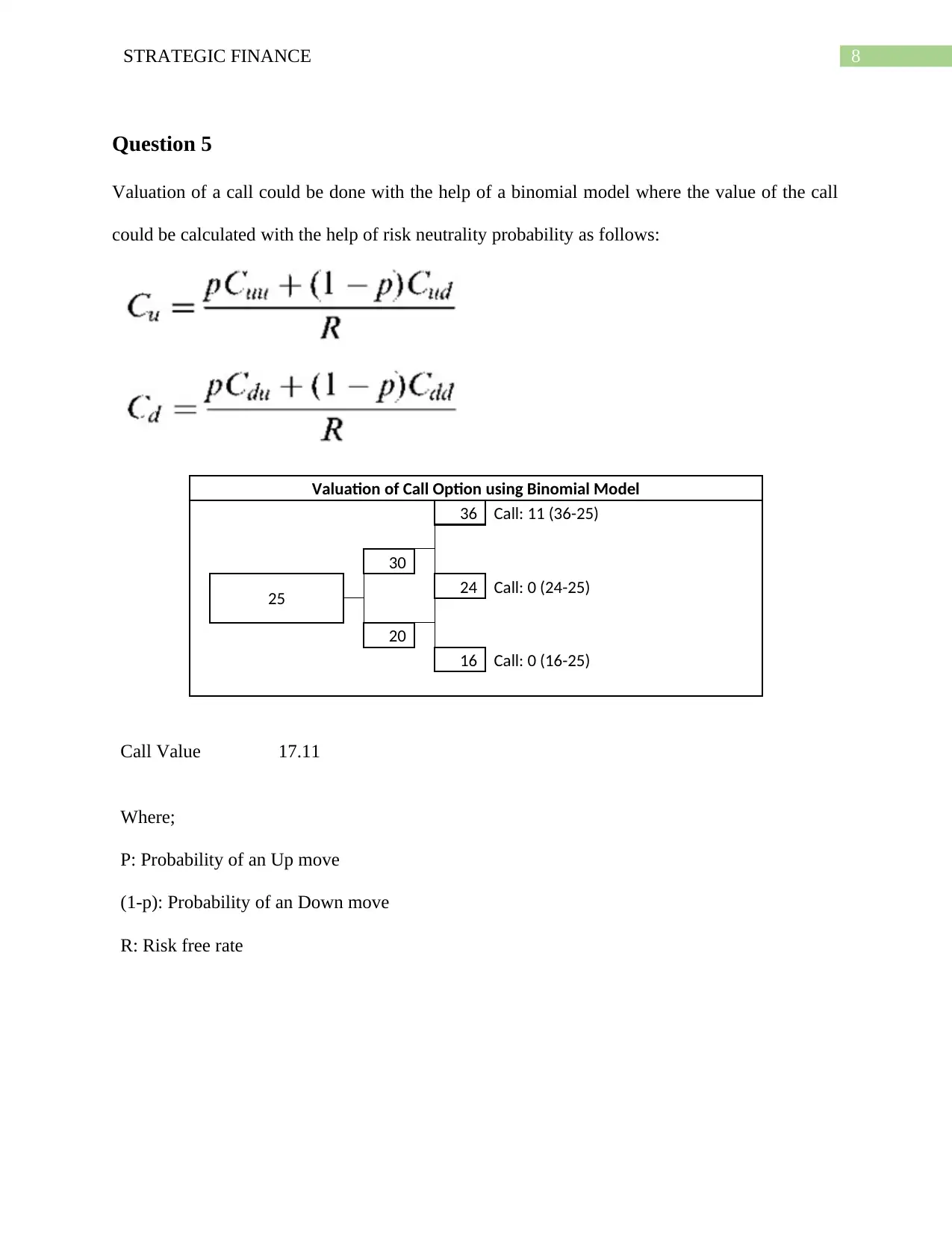
8STRATEGIC FINANCE
Question 5
Valuation of a call could be done with the help of a binomial model where the value of the call
could be calculated with the help of risk neutrality probability as follows:
Valuation of Call Option using Binomial Model
36 Call: 11 (36-25)
30
25 24 Call: 0 (24-25)
20
16 Call: 0 (16-25)
Call Value 17.11
Where;
P: Probability of an Up move
(1-p): Probability of an Down move
R: Risk free rate
Question 5
Valuation of a call could be done with the help of a binomial model where the value of the call
could be calculated with the help of risk neutrality probability as follows:
Valuation of Call Option using Binomial Model
36 Call: 11 (36-25)
30
25 24 Call: 0 (24-25)
20
16 Call: 0 (16-25)
Call Value 17.11
Where;
P: Probability of an Up move
(1-p): Probability of an Down move
R: Risk free rate
⊘ This is a preview!⊘
Do you want full access?
Subscribe today to unlock all pages.

Trusted by 1+ million students worldwide
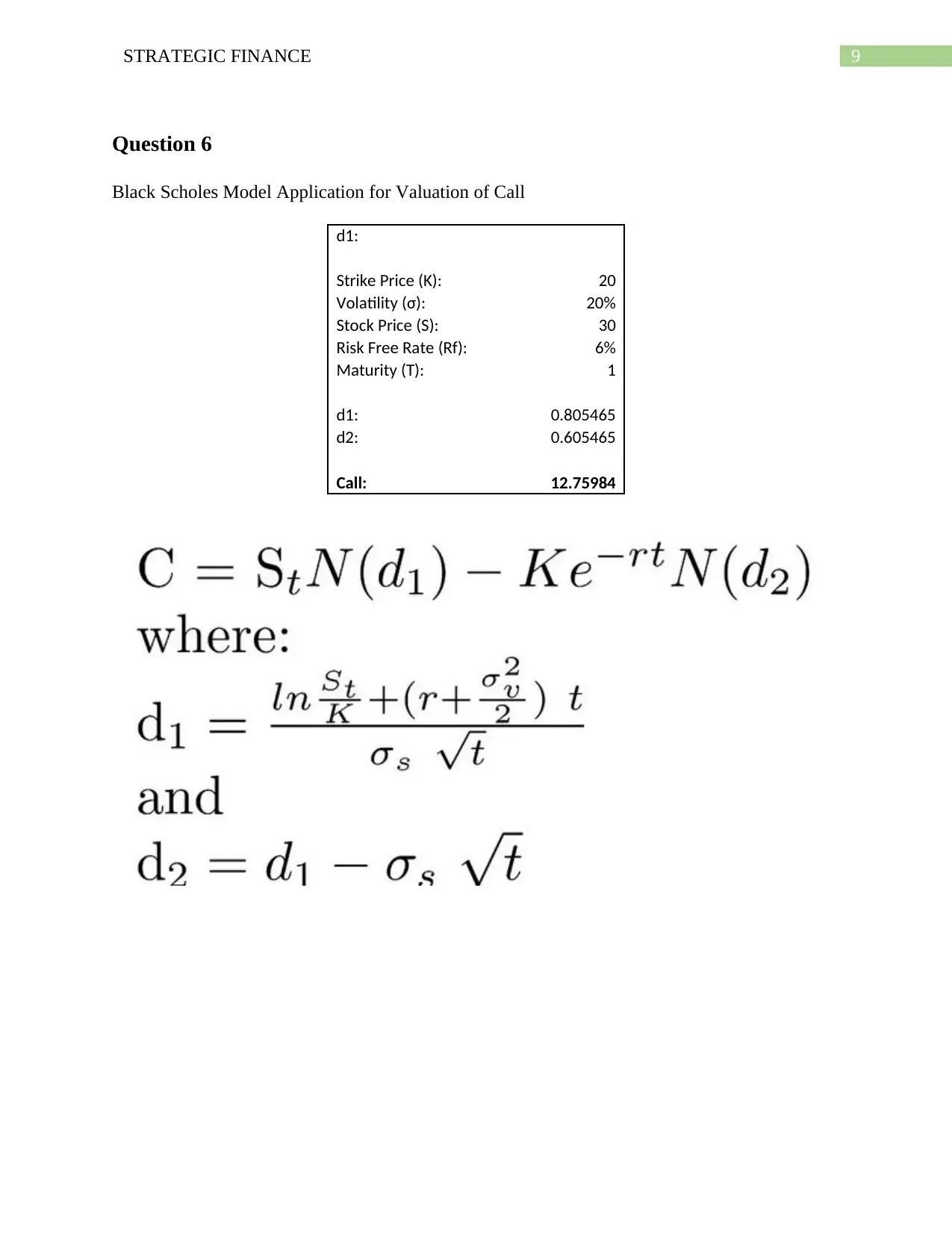
9STRATEGIC FINANCE
Question 6
Black Scholes Model Application for Valuation of Call
d1:
Strike Price (K): 20
Volatility (σ): 20%
Stock Price (S): 30
Risk Free Rate (Rf): 6%
Maturity (T): 1
d1: 0.805465
d2: 0.605465
Call: 12.75984
Question 6
Black Scholes Model Application for Valuation of Call
d1:
Strike Price (K): 20
Volatility (σ): 20%
Stock Price (S): 30
Risk Free Rate (Rf): 6%
Maturity (T): 1
d1: 0.805465
d2: 0.605465
Call: 12.75984
Paraphrase This Document
Need a fresh take? Get an instant paraphrase of this document with our AI Paraphraser
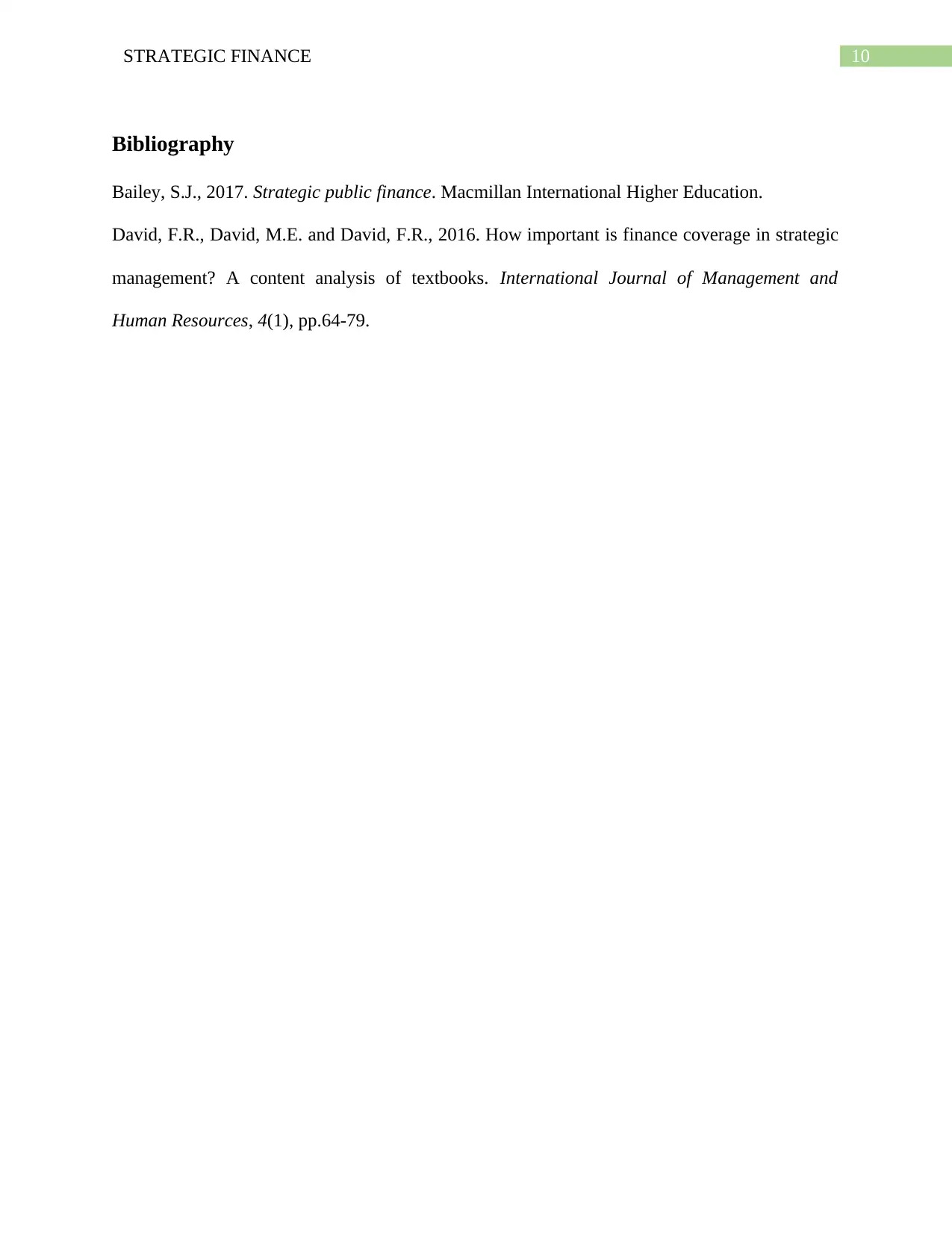
10STRATEGIC FINANCE
Bibliography
Bailey, S.J., 2017. Strategic public finance. Macmillan International Higher Education.
David, F.R., David, M.E. and David, F.R., 2016. How important is finance coverage in strategic
management? A content analysis of textbooks. International Journal of Management and
Human Resources, 4(1), pp.64-79.
Bibliography
Bailey, S.J., 2017. Strategic public finance. Macmillan International Higher Education.
David, F.R., David, M.E. and David, F.R., 2016. How important is finance coverage in strategic
management? A content analysis of textbooks. International Journal of Management and
Human Resources, 4(1), pp.64-79.
1 out of 11
Related Documents
Your All-in-One AI-Powered Toolkit for Academic Success.
+13062052269
info@desklib.com
Available 24*7 on WhatsApp / Email
![[object Object]](/_next/static/media/star-bottom.7253800d.svg)
Unlock your academic potential
Copyright © 2020–2025 A2Z Services. All Rights Reserved. Developed and managed by ZUCOL.





